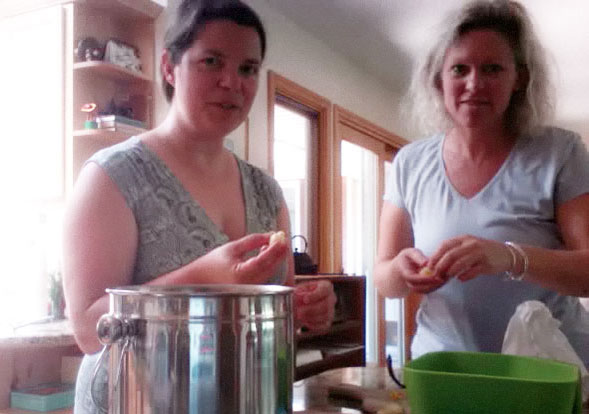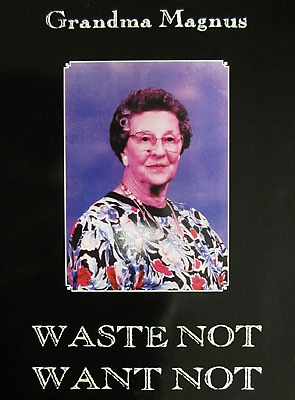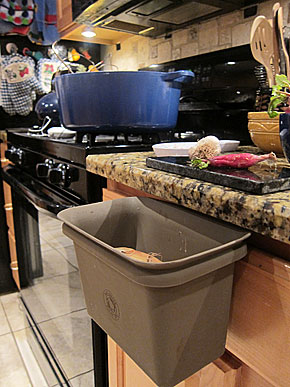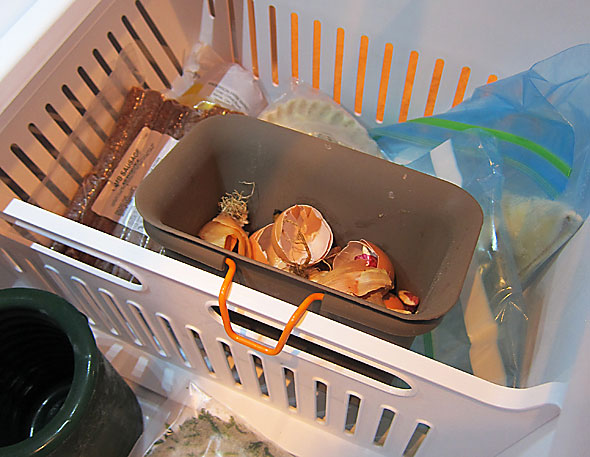

BLOG-Waste not. Want not. Worry not.
- Published: January 21, 2012
This past year I took a course in organic gardening. In an all round rewarding experience, the subject that intrigued me most was compost. One reason may be my childhood fascination with mud pies. More likely, the practice perfectly embodies the values of my paternal grandmother. First it is practical. Second it is penny-wise.
 Grandma Magnus was a woman of the Great Depression—strong, pragmatic, resolute. A third grade teacher with an imposing reputation and an eagle eye, she instructed her grandchildren in the art of frugality.
Grandma Magnus was a woman of the Great Depression—strong, pragmatic, resolute. A third grade teacher with an imposing reputation and an eagle eye, she instructed her grandchildren in the art of frugality.
We learned the charm of wrapping presents in brown paper bags, the value of hanging laundry to dry, and importance of cleaning our plates down to the last crumb. In tribute, my sisters keep a picture of her at their Colorado deli where she warns their patrons: “Waste not. Want not.”
Through composting, a family can reduce their household waste by 60%. Onsite recycling translates to one less trash can to carry to the curb and far less transportation costs to cart our stuff away.
Composting turns yard waste, food scraps, and paper trash into soil and fertilizer; little need be rejected and much is renewed in service to the garden. Mulching with compost cuts down on weeding and amends the soil. Our neighbors to the immediate west and east of our property have amazing, lush landscapes. Both households compost and, from their example, persuaded me to start. Our west-side neighbors have the most extensive system. Their pile wraps the backyard fence and provides them with a steady source of humus.
 Following their lead, I started a compost pile behind our shed where we collect brush and grass clippings. From the gardening class, I learned the idea size for the compost heap; and, accordingly, the pile is maintained at least one yard high, deep, and wide to keep it cooking.
Following their lead, I started a compost pile behind our shed where we collect brush and grass clippings. From the gardening class, I learned the idea size for the compost heap; and, accordingly, the pile is maintained at least one yard high, deep, and wide to keep it cooking.
Inside our home, I have tried a few methods for collecting scraps: a kitchen pail with a charcoal filter, a worm bin, a diligent husband. My current favorite is the “scrap happy” compost bin from Eco-Mental, 257 Xenia Ave. During food prep, the bin hooks onto a drawer so I can scrape odd ends inside. Then, the bin stores in the freezer until the next compost pile run. Freezing the food waste eliminates odors and pesky flies.
Thank you, Rhonda, for this brilliant solution. If you too are intrigued by composting, an excellent resource is Composting to Reduce the Waste Stream: A Guide to Small Scale Food and Yard Waste Composting. This tutorial details the construction and maintenance of household-scale systems. For an exhaustive list of compostable materials, reference the On-Farm Composting Handbook.

Starting a compost pile is easy once you find it space. Feeding it is low, steady maintenance. Harvesting the enriched humus from the pile’s base is the hardest part, but put that good gravy to use and make Grandma proud.
The Yellow Springs News encourages respectful discussion of this article.
You must login to post a comment.
Don't have a login? Register for a free YSNews.com account.













No comments yet for this article.